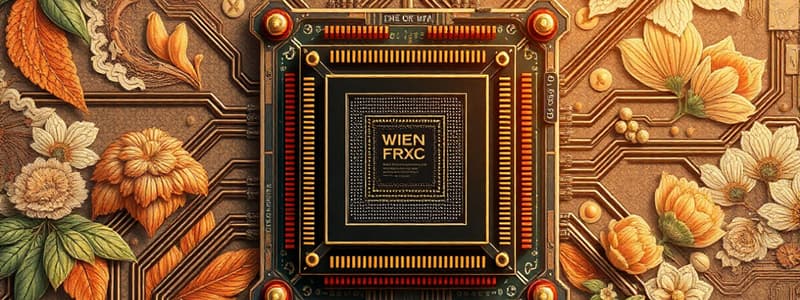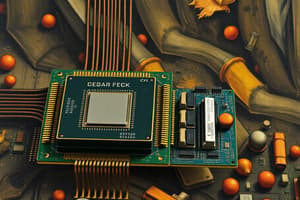Podcast
Questions and Answers
Which of the following devices would NOT be considered a peripheral device?
Which of the following devices would NOT be considered a peripheral device?
- Central Processing Unit (CPU) (correct)
- Monitor
- External Hard Drive
- Keyboard
Which type of device primarily translates external data into signals understood by the computer?
Which type of device primarily translates external data into signals understood by the computer?
- Network Interface Card
- Input Device (correct)
- Output Device
- Expansion Card
Which of the following is NOT an example of an expansion card?
Which of the following is NOT an example of an expansion card?
- Video Card
- Hard Disk Drive (correct)
- Network Interface Card
- Sound Card
What is the primary function of a Network Interface Card (NIC)?
What is the primary function of a Network Interface Card (NIC)?
Which of the following best describes the role of the motherboard in a computer system?
Which of the following best describes the role of the motherboard in a computer system?
Which of these components is responsible for interpreting and executing instructions received from the operating system?
Which of these components is responsible for interpreting and executing instructions received from the operating system?
Which of these options best describes the function of a Graphics Processing Unit (GPU)?
Which of these options best describes the function of a Graphics Processing Unit (GPU)?
Which type of memory retains data even when the computer is powered off?
Which type of memory retains data even when the computer is powered off?
Which of these is NOT a characteristic of a Solid State Drive (SSD)?
Which of these is NOT a characteristic of a Solid State Drive (SSD)?
Which component serves as the main circuit board connecting all other components in a computer?
Which component serves as the main circuit board connecting all other components in a computer?
Which type of memory is considered volatile and loses data when the computer is powered off?
Which type of memory is considered volatile and loses data when the computer is powered off?
Which of these options accurately describes the relationship between clock speed and CPU performance?
Which of these options accurately describes the relationship between clock speed and CPU performance?
Which component plays a crucial role in enabling parallel processing and enhancing overall performance?
Which component plays a crucial role in enabling parallel processing and enhancing overall performance?
Flashcards
Computer Communication
Computer Communication
The process that ensures all computer parts work together and share information.
Input Devices
Input Devices
Devices that allow users to provide data to a computer, like keyboards and mice.
Output Devices
Output Devices
Devices that display or present information from the computer, such as monitors and printers.
Peripheral Devices
Peripheral Devices
Signup and view all the flashcards
Network Interface Card (NIC)
Network Interface Card (NIC)
Signup and view all the flashcards
Central Processing Unit (CPU)
Central Processing Unit (CPU)
Signup and view all the flashcards
Clock Speed
Clock Speed
Signup and view all the flashcards
Multiple Cores
Multiple Cores
Signup and view all the flashcards
Random Access Memory (RAM)
Random Access Memory (RAM)
Signup and view all the flashcards
Volatile Memory
Volatile Memory
Signup and view all the flashcards
Hard Disk Drive (HDD)
Hard Disk Drive (HDD)
Signup and view all the flashcards
Solid State Drive (SSD)
Solid State Drive (SSD)
Signup and view all the flashcards
Graphics Processing Unit (GPU)
Graphics Processing Unit (GPU)
Signup and view all the flashcards
Study Notes
Central Processing Unit (CPU)
- The CPU is the brain of a computer, responsible for executing instructions.
- It fetches instructions from memory, decodes them, and performs the necessary operations.
- Different types of CPUs exist, varying in speed and processing power.
- Modern CPUs are highly complex integrated circuits capable of executing billions of instructions per second.
- Clock speed, measured in Hertz (Hz), impacts the CPU's processing capability. Higher clock speeds typically indicate faster processing.
- Multiple cores are becoming increasingly common in modern CPUs, enabling parallel processing and significant performance improvements.
Random Access Memory (RAM)
- RAM is a volatile memory that stores data and instructions currently being used by the CPU.
- It provides fast access for the CPU to retrieve and store data compared to other storage devices.
- RAM is critical for a computer's overall performance, as the more RAM a computer has, the more programs and data it can hold in active use.
- Data in RAM is lost when the computer is powered off.
- Different types of RAM exist, with variations in speed and capacity. DDR4, DDR5 are common examples.
Hard Disk Drive (HDD)
- HDDs are non-volatile storage devices that store large amounts of data permanently.
- Data is stored on spinning platters with magnetic heads that read and write data.
- HDDs are generally less expensive per gigabyte of storage than other storage options like SSDs.
- HDDs are slower than SSDs due to the mechanical nature of the storage mechanism.
Solid State Drive (SSD)
- SSDs are non-volatile storage devices that use flash memory to store data.
- They have no moving parts, making them faster and more reliable than HDDs.
- Data access speeds are dramatically faster, resulting in noticeably quicker boot times, application loading, and overall performance.
- SSDs are more expensive than HDDs per gigabyte of storage.
Graphics Processing Unit (GPU)
- GPUs are specialized processors designed for handling graphical tasks.
- They accelerate the rendering of images, videos, and other visual content.
- GPUs are essential for tasks like gaming, video editing, and 3D modeling.
- Modern GPUs often include more processing cores than CPUs, optimized for parallel processing.
Motherboard
- The motherboard is the main circuit board of a computer.
- It connects all other components together.
- It provides power, communication channels, and slots for expansion cards.
- Critical for ensuring all computer parts operate correctly and interoperate together.
- Enables communication between different components like CPU, RAM, storage devices, and expansion cards.
Input Devices
- Input devices allow users to provide input to the computer.
- Examples include keyboards, mice, touchscreens, and webcams.
- They translate external data (e.g., typed text) into signals understood by the computer.
Output Devices
- Output devices display information processed by the computer.
- Examples include monitors, printers, speakers, and projectors.
- They present the results of computer processing in a user-friendly format.
Peripheral Devices
- Peripheral devices are any external device connected to the computer.
- They include all input and output devices.
- Printers, scanners, and external hard drives are examples of peripherals.
Network Interface Card (NIC)
- NICs are hardware components that enable a computer to connect to a network.
- They provide the physical connection between the computer and the network.
- Different types cater to network technologies (e.g., Ethernet, Wi-Fi).
Expansion Cards
- Expansion cards enhance the functionalities of a computer by adding specific capabilities.
- Examples include sound cards, video cards, and network interface cards.
- They plug into slots on the motherboard to extend computer functionality.
Studying That Suits You
Use AI to generate personalized quizzes and flashcards to suit your learning preferences.




